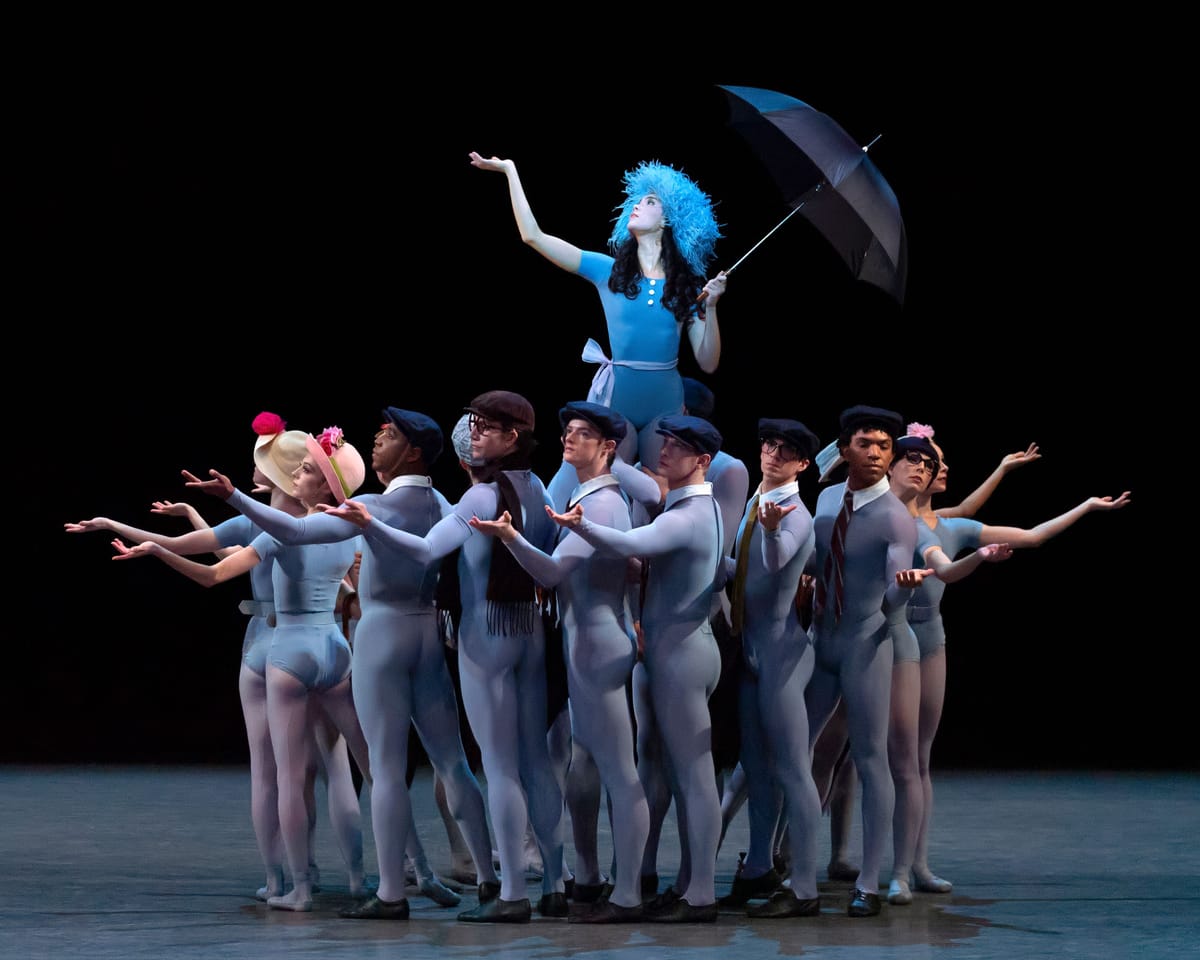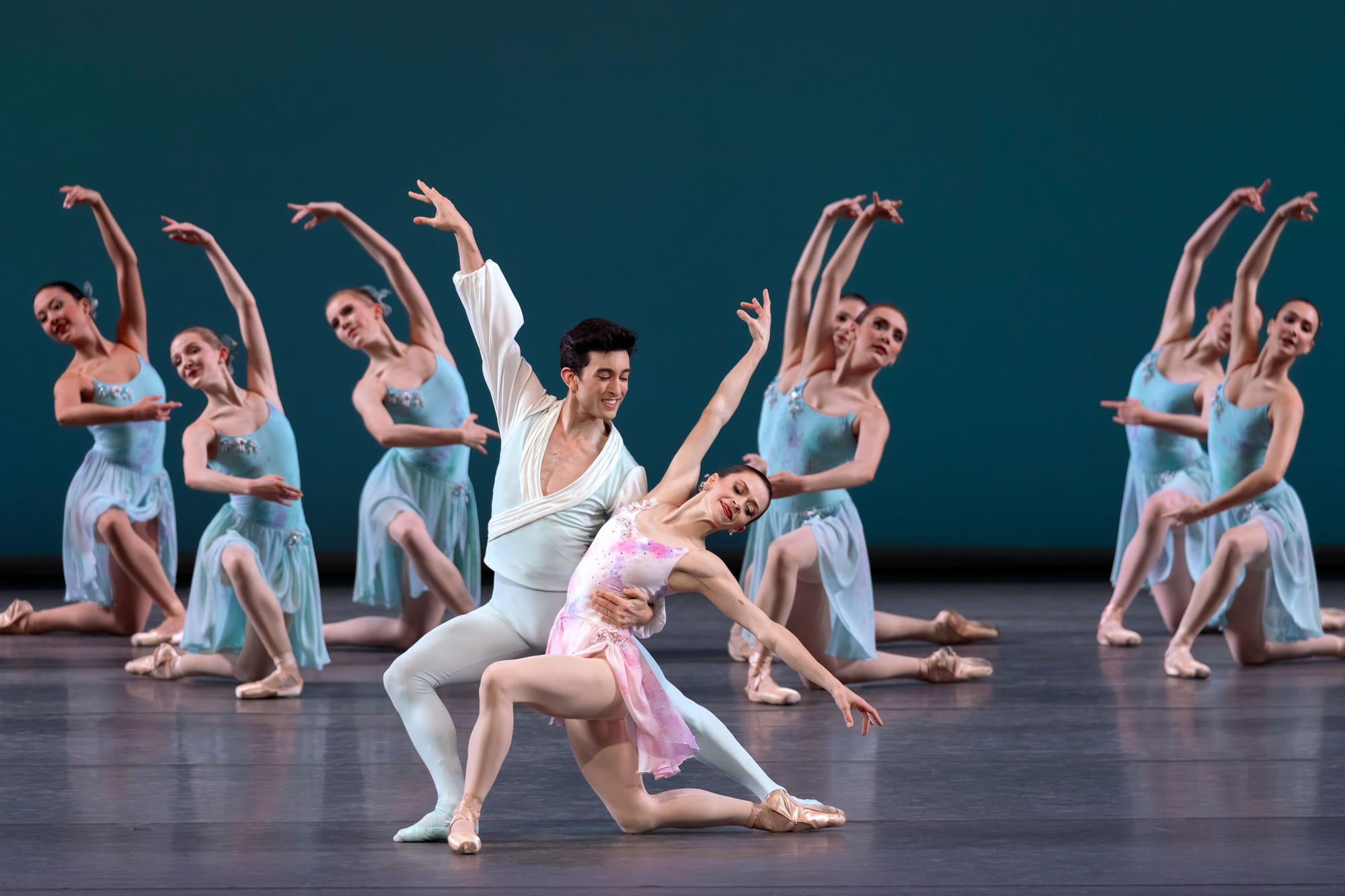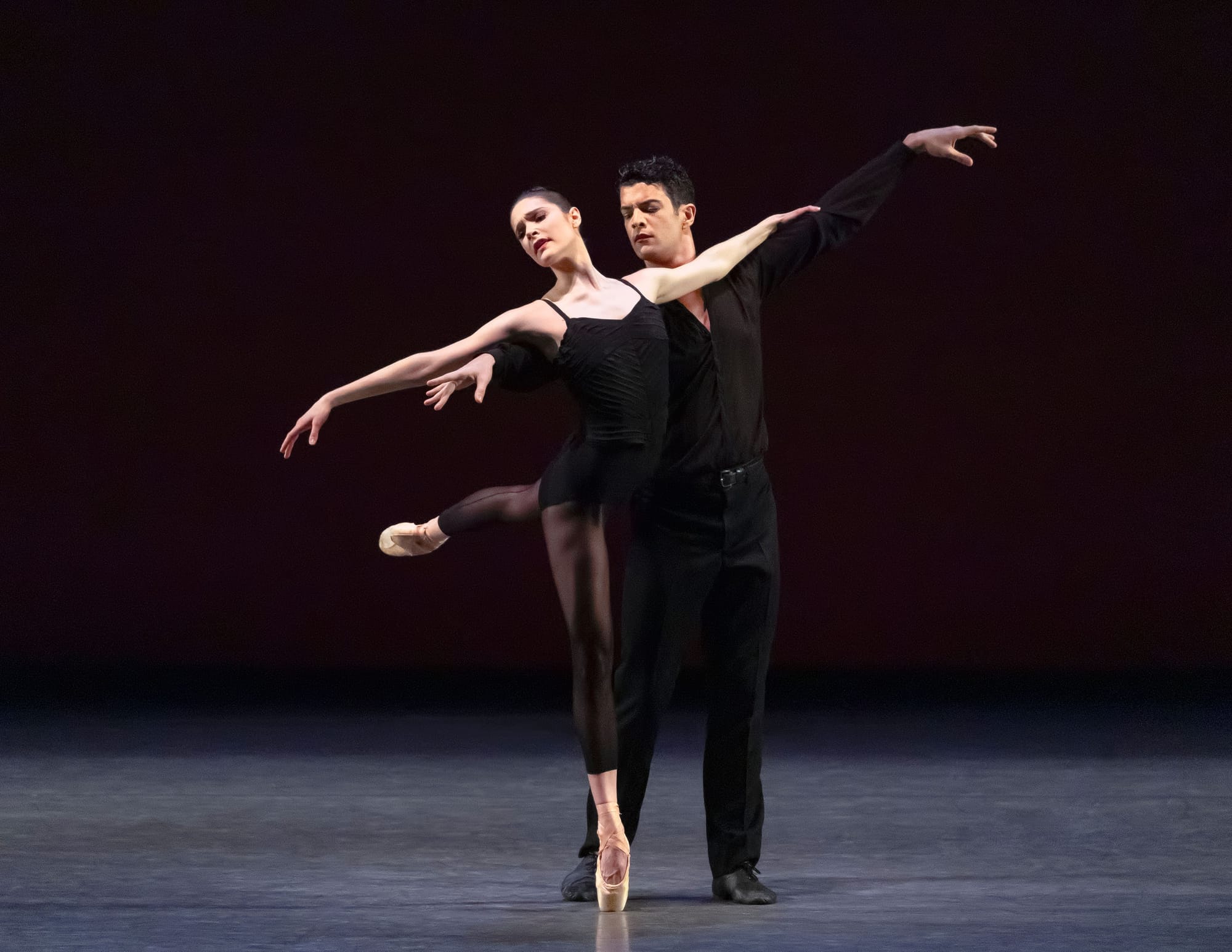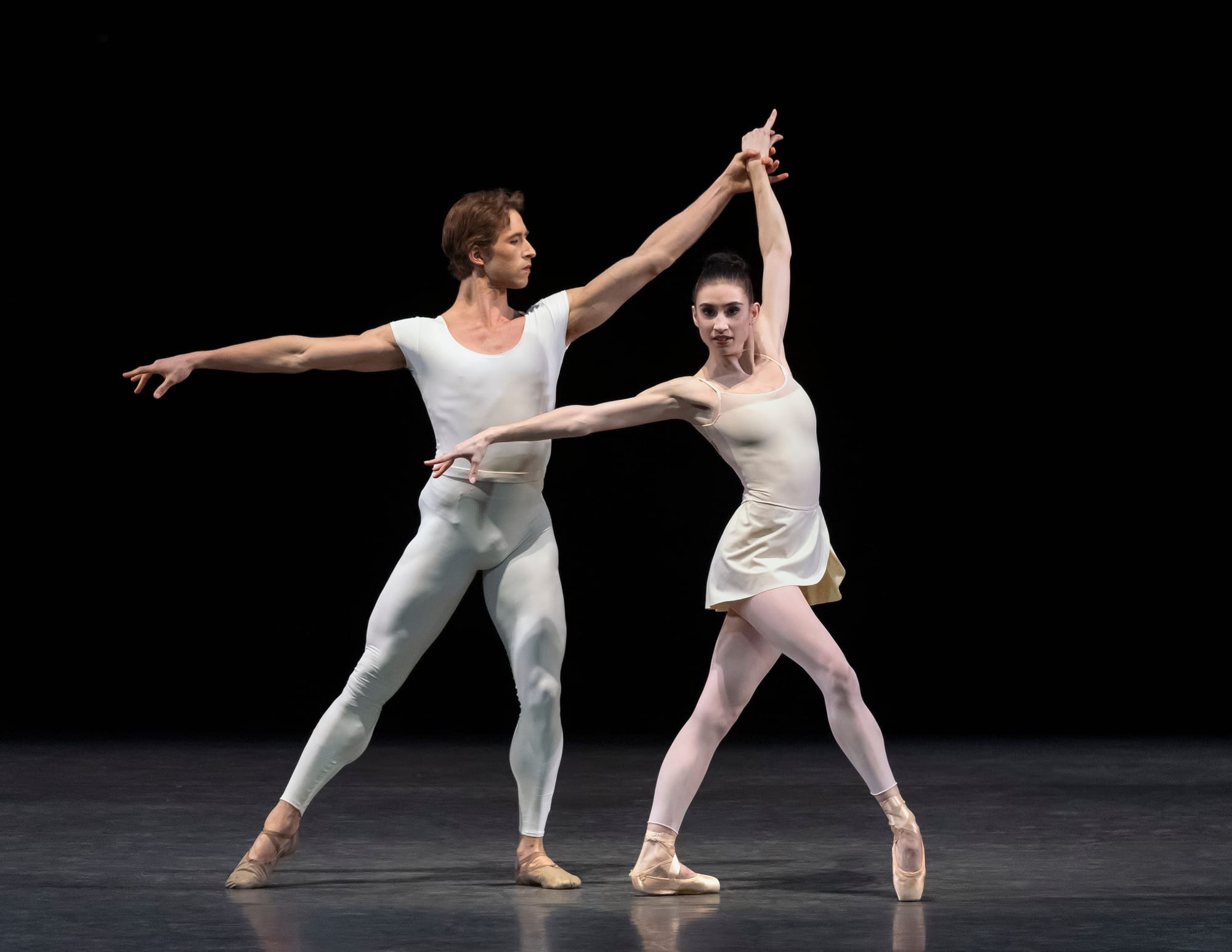Something for Everyone

Something for Everyone
"Ballo della Regina", "In a Landscape", "Hallelujah Junction", "The Concert"
New York City Ballet
David H. Koch Theater
Lincoln Center
New York, New York
February 9, 2024
This varied program began with Balanchine’s “Ballo della Regina”, a luscious soap bubble set to Verdi, continued with two more astringent ballets, a revival of Albert Evans’ “In a Landscape” to John Cage followed by Peter Martins’ high energy “Hallelujah Junction” to John Adams, and ended with Jerome Robbins’ “The Concert”, a romp to Chopin. The dancers coped very well with the different styles and the dancing, which included a number of debuts, was uniformly exciting.

The nineteenth century roués of the Parisian Jockey Club were after excitement too, and insisted seeing a ballet in the middle of an opera so they could enjoy watching women’s legs after dinner; this rather disreputable practice has given us some of the most luscious, danceable tunes around. Balanchine used Verdi’s ballet music from “Don Carlos” not to show off his dancers’ legs but to show off one dancer's sparking feet—it is a salute to Merrill Ashley’s diamond sharp technique. The original ballet told the story of a peasant looking for a pearl and some of the underwater feel remains, as the all-female corps occasionally makes little swimming gestures with their arms, but there is no real story, just a feast of joyful, bouncy dancing. Megan Fairchild and Anthony Huxley were danced the lead couple. Fairchild is smaller and less commanding than Ashley, but she has a vivid and pristine technique, and the glorious hops on point and quick changes of direction were secure and sparkling; she radiated fun. Huxley flew through the elegant petit batterie, flowing through his jumps and turns, and made the tricky partnering look easy.
The four brief solos for the demis (Alston Macgill, Emma von Enck, Ashley Hod, and Olivia MacKinnon, all debuts), were exhilarating, especially Hod’s soaring jumps. I first noticed Macgill, who joined NYCB in 2016, in 2017 dancing a featured role in Peter Martins’ “Fearful Symmetries”, when she shone like a beam of light through the ballet’s incessant industrial energy. She soon disappeared, out with a serious injury, and it is so good to have her back
and dancing so confidently.
Though “Ballo” has no clear plot, it does have an arc, starting quietly; the principals begin with a slow, flowing adagio, and building up to the fast, explosing footwork; Balanchine knew how to shape a work. This art seems to be on the wane; the two middle pieces used one gear throughout. Albert Evans choreographed “In a Landscape”, a pas de deux for Wendy Whelan and Philip Neal, in 2005 for NYCB’s opening night gala; it was recreated from a video by the former NYCB dancer Rebecca Krohn and danced by Ava Sautter and Gilbert Bolden III.

It was a rather bleak affair, with the couple physically connected but impassive. The staging was striking, beginning and ending with a dark shadow (Bolden) seeming to pull Sautter along the ground. (An article about the revival posted by NYCB https://www.nycballet.com/discover/stories/reviving-albert-evans-in-a-landscape/ says Evans was inspired by the Nutcracker slide.) The pas de deux, danced with a fierce intensity, rambled a bit, with lots of cactus arms, dead bug poses, and death spirals. Sautter, a corps dancer, was magnificent, tall and commanding, with a cool and hypnotic confidence. Bolden was a generous and dignified partner, making the pretzel poses look easy. It was a quietly flashy work, but emotionally inert.
Peter Martins’ “Hallelujah Junction”, from 2002, is also flashy but not quiet and is set to the pounding, insistent, eponymous music for two pianos by John Adams. The setting is striking, with the two pianists (Stephen Gosling and Susan Walters) dominating the back of the darkly lit stage, while the dancers, some in black and some in white, romp in the bright upstage lights. The three principal dancers (Alexa Maxwell, Joseph Gordon, and KH Takahashi) were all making their debuts, Maxwell and Gordon in white and Takahashi in black, and looked well-rehearsed and eager. Takahashi, in what must be called the jester role, showed off his soft, easy jumps (such beautiful landings) and spun like a top.

Maxwell snaked through her solos, and was almost defiantly limp in the brief pas de deux, slumping over Gordon’s shoulders, but it was really just another “woman is a bag of potatoes” dance with little connection between the two. Martins’ use of his corps, however, was striking and the four men in white and the four women in black wove through some intriguing patterns. They broke into four couples (Jacqueline Bologna with Jules Mabie, Nieve Corrigan and Andres Zuniga, Alston McGill with Victor Abreu, and Mary Thomas McKinnon with Kennard Henson) and each had a brief, vigorous pas de deux which showed off their ability to move. But like so many Martins’ ballets, “Hallelujah Junction”, for all its striking structural complexity, was a burst of adrenaline with little substance; a fine and exciting aerobics class which gave the dancers a lot to do and little to be.
Jerome Robbins” 1956 “The Concert” gave the dancers a lot to be; it is a rare ballet buffa making fun of so many romantic conventions. The opening drop cloth is a cartoon theater drawn by New Yorker cartoonist Saul Steinberg with a small stage with what looks like a moon and a tree, which, in 1956, with the Chopin introduction, could only mean “Les Sylphides” to a ballet audience. Elaine Chelton, as the pianist, was a deadpan martinet striding on and glaring at the audience as she ponderously prepared for her concert, barely acknowledging her stage audience as the ticket holders straggled in, and blithely ignoring their fantasies as she played on until she couldn't take it anymore and chased them away with her butterfly net; a fantasy, perhaps, of many concert artists.
These fantasies included poor Andrew Veyette, as prissy Meaghan Dutton-O’Hara’s henpecked husband, dragged unwillingly to some uplifting culture. Veyette was very funny, a poor man’s Groucho Marx, chomping his cigar and trying to read his paper—nowadays he would be desperately checking his cell phone for the latest sports scores. Mira Nadon, in her debut as the oblivious romantic, was so lost in the music that she could float. With her hair loose and her long, elegant legs, I expect Veyette wasn’t the only bored husband with dreams of running off with her.
Robbins’ sharply observed comedy still hits home; daydreaming at a concert is certainly not out of fashion, even if the hats ladies yearn for now would not include a blue feather dust-mop. And certainly the lyrical Chopin music has set many people dreaming of floating around on stage like butterflies. It was a cheerful ending to a varied program, and I’m sure that many people left dreaming of seeing more of Ava Sautter.
© 2024 Mary Cargill



